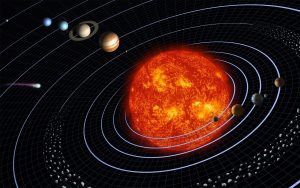 Astrology is a multifaceted discipline that I use to better develop many of my characters. In this installment, I am covering the aspects between the planets and how they relate to one another.
Astrology is a multifaceted discipline that I use to better develop many of my characters. In this installment, I am covering the aspects between the planets and how they relate to one another.
Catch up on previous astrology blogs
Astrology- The Planets Astrology- The Signs (part 1)Astrology- The Signs (part 2)Astrology-The Signs (Part 3)
Understanding what the planets and signs represent are important facets of astrology, but categorizing people into boxes based on planets and signs isn’t really the point. Astrology is a discipline focused not just on how things work, but also on how they work together; it really starts teaching us about ourselves and our world when we start examining the relationships between the planets.
What is an Aspect?
An astrological chart is traditionally drawn up as a circle or ring. We then divide that ring into twelve parts, one sign per part, with the planets placed along the edge. When you draw a line from one planet on the edge to the center of the circle, then draw a line from a different planet to the center, it forms and angle. The angle that these lines form the aspect between the planets.
The aspects between planets are significant factors in properly reading any astrological chart. They are key to understanding where the path might be easier for the subject and where it’s likely to be more challenging. The more stressful aspects are called hard aspects, while the easier to manage aspects are referred to as soft aspects.
Aspects between signs in a synastry chart illustrate the relationship between the people involved, a person’s natal (birth) chart will reflect them personally, and transits to their planets will often denote changes in the individual’s external circumstances.
Astrological Orbs

Aspects do not have to be exact to influence an individual’s chart. Each aspect has an orb of influence, or the amount that the aspect can be separated from exact and still exert an influence on the chart. The orb of influence can range from just two degrees of separation to ten, depending on a number of factors.
Factors that can affect the size of the orb of influence include the type of chart you are analyzing, which planets are involved, and the aspect involved. The closer to exact the aspect is, the more weight it will typically carry in the analysis of the chart.
Major Aspects
Claudius Ptolemy described five aspects in his second-century text, the Tetrabiblos. These five aspects, trine, square, sextile, opposite, and conjunct, are the major aspects, sometimes referred to as Ptolemaic aspects. Signs that are opposite or square one another have a hard aspect while those that are trine or sextile have a soft aspect. Conjunctions can be either hard or soft, depending on the planets involved.
Opposite
Planets that are 180 degrees apart are opposite one another on the astrological wheel. These planets will share the same modality, be that fixed, cardinal, or mutable, but different elements will represent them. Fire is opposite air, and water opposite earth.
This is a challenging aspect rooted in extreme tension, but it can also be extremely constructive. Learning how to deal with an opposition is all about balance and compromise. While it may be difficult to strike a balance between opposites, once that balance is found it can enhance the benefits for both sides of the opposition.
Trine
An angle of 120 degrees between celestial bodies is referred to as a trine. Planets trine each other are ruled by signs with the same element—earth, air, fire, or water—but with differing modalities.
This is a beneficial aspect related to harmony and ease. In birth charts, trines are considered an indicator of natural talent or ability, and they denote areas of easy agreement between the parties when seen in synastry charts. Transits that trine your birth planets tend to indicate a time when it may become easier for you to work with that particular planet’s energy.
While these are all typically positive effects, the ease offered by the trine can cause the chart holder to take their innate ability for granted and squander it.
Square
A square aspect occurs when planets sit at a 90-degree angle to each other. Like the opposition aspect, this aspect involves planets with the same modality, but different elements. There is a tension here as well—each element pushes against the other—but the tension is less direct, therefore less predictable, and often more difficult to manage.
Finding the balance between planets square to one another is more of a challenge than even balancing planets in opposition, but it can be well worth the effort. While this difficult aspect is often initially destabilizing, it can lead to powerful motivation and rapid growth when both elements of the square are properly honored.
Sextile
A sextile aspect, when two planets are 60 degrees apart, is a soft aspect like the trine. While neither the element nor the modality match for sextile planets, they are typically supportive of one another. Information and energy flow easily between the two planets, although a little more effort is involved than with a trine.
Of the major aspects, the sextile is said to have the least influence. It neither pushes an individual into action nor does it interfere with actions taken. It’s an unobtrusive aspect that’s easy to overlook—keep an eye out for it. Sextile planets may reveal hidden talents, bring joy from unexpected spheres, or initiate new connections we may otherwise miss.
Conjunct
Planets that sit at exactly the same degree, or within just a few degrees, are conjunct. When planets are conjunct one another, they blend their energies together. This aspect can be either soft or hard, depending on which planets and signs are involved.
Conjunctions can express both a positive effect and a corresponding negative effect at the same time. Someone with Moon conjunct Mercury in their natal chart may find it easy to discuss their feelings, but difficult to separate their thoughts from their emotions. Sun conjunct moon is typically positive in a synastry chart as it shows a relationship that is emotionally supportive to the moon individual. Sun conjunct Mars or Pluto, on the other hand, could indicate power struggles and conflict between the parties.
In most cases, conjunct planets are represented by the same astrological sign. Due to the orb of influence, however, you will sometimes see planets that are close enough to be conjunct but are represented by neighboring signs. As an example, a planet at 29 degrees of Leo would be considered conjunct a planet at 1 degree of Virgo. Out of sign conjunctions are more challenging to work with than those in the same sign, but the complexity of the out of sign conjunction can yield noteworthy results.
Minor Aspects

There are several minor aspects to take into consideration when interpreting an astrological chart, some more commonly analyzed than others. Minor aspects carry less weight than major aspects when reading an astrological chart and have much smaller orbs than major aspects do. The three listed here, inconjunct, semi-sextile, and semi-square, are the minor aspects I use and hear about most frequently.
Inconjunct
Planets that are 150 degrees from one another are referred to as inconjunct or quincunx. Like the sextile, these two planets are in signs that share neither element nor modality. Unlike the planets with a sextile aspect, however, signs that are quincunx one another don’t play as well together. It often requires deliberate compromise before these energies can stabilize.
Like squares and oppositions, the energies from the two quincunx planets may be difficult to integrate, but each must be respected to find balance. For instance, a person with Venus in Cancer quincunx their Mars in Sagittarius will need to strike a balance between their desire for a cozy, intimate home setting, from Venus in Cancer, with an equally strong drive to take risks and experience new things from the Saturn in Sagittarius. While inconjunct planets have similar characteristics to other hard aspects, they denote a fairly weak aspect in the chart which is often overshadowed by major aspects.
Semi-Sextile
Planets that are 30 degrees apart are labeled as semi-sextile. This is a soft aspect that involves planets that are neighbors on the astrological wheel. These planets have contrasting elements and modalities, which causes some tension, but the energies are overall complementary to one another.
The relationship between semi-sextile planets is often uncomfortable for the chart holder or holders, but, like good neighbors, these planets tend to prop one another up. Taurus provides stability to the impetuous nature of Aries, while Aries spurs the normally placid Taurus into action. Like all neighbors, however, there can occasionally be friction, especially when one element is emphasized over the other.
Semi-Square
When planets are 45 degrees apart, within one or two degrees, they are said to be semi-square. Celestial objects may be semi-square to a planet in a neighboring sign or in the sign after that, and they share neither element nor modality. This hard aspect is easy to miss when exploring a chart, and is often overlooked even by experienced dabblers.
While considered a minor aspect under most circumstances, it is worth noting. This particular aspect can an indicator that certain patterns of external events—a string of unsuitable relationships, failed ventures, or even recurring illnesses—may have an origin in the chart holder’s psyche. As the relationship between these conflicting elements develops and matures, it can lead to exceptional persistence and endurance.
Aspect Patterns
Sometimes these aspects create larger patterns that denote particularly intense and often complex qualities within the chart. Some, like the grand cross, can denote an especially challenging aspect within the chart, while others, such as the grand trine, point to areas that can be more easily capitalized on.



Your astrological guidance has been a guiding light in my life. I can’t thank you enough for the clarity you’ve brought into my journey.
Thank you for your kind comments!
Very informative and well-written, Penny. You covered much of the basics in a clear manner that makes it easy for the astrology newbie to understand. This article mirrors a lesson plan I’ve received as student at the International Academy of Astrology, so there is no question its validity and applicability to the serious, professional student. Bravo!